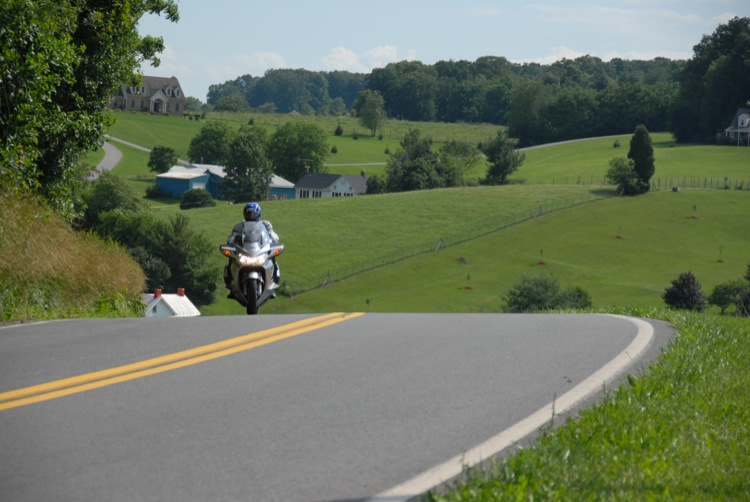Pennsylvania, Maryland, Virginia, and West Virginia

"A house divided against itself cannot stand. I believe this government cannot endure permanently half slave and half free. I do not expect the Union to be dissolved; I do not expect the house to fall; but I do expect that it will cease to be divided."Abraham Lincoln 1858
The ensuing Civil War was the bloodiest conflict ever endured by America. Although virtually every state in the Union was involved in the conflict, many of the pivotal battles and events took place in Pennsylvania, Maryland, and Virginia.
Crossing the Potomac
It's fitting that our tour begins not far from the Potomac River in Leesburg, VA, a town named after an ancestor of the iconic leader of the Confederate Army of Northern Virginia - Robert E. Lee. I meet riding partner Jeff Arpin, on his silver Honda ST 1300, for breakfast at the Leesburg Restaurant before embarking on our five-day tour of Mid-Atlantic Civil War sites.

Crossing the Potomac River aboard White's Ferry, we're not far from where Lee's army forded the river during its two invasions of the North. The Confederate flag flapping in the breeze on the far shore is a reminder that many people in border-states, like Maryland, were divided in their support between the North and South; some of those divergent loyalties are still apparent 140 years later.
Low hanging, leaden clouds greet our arrival in Maryland. The rain starts slowly, at first, but soon intensifies as we work our way along tree-shrouded, rain-slick backroads that once were the likely path followed by invading Confederate soldiers. In Frederick, MD we stop for a tour of the National Museum of Civil War Medicine.
Motorcycles & Gear
2004 Honda ST 1300A
2007 Honda ST 1300A
Helmet: Shoei X-Eleven
Jacket & Pants: Olympia Viper Mesh
Boots: Alpinestars
Gloves: Fieldsheer
The two-story building houses exhibits of both the medical implements used by doctors and life-sized scenes of typical battlefield medical stations during the Civil War.
The docent tells us that the practice of medicine in the 1860s had not advanced much from the way it was administered by the ancient Greeks. Bloodletting and amputations were a common form of treatment and, because there was no germ theory at this time, most Civil War deaths were the result of infection, not bullets.
After a bountiful lunch at Johanssons in the picturesque college town of Westminster, MD, we meander further north under a now clear cerulean sky that lifts our spirits and quickens our pace. At mid-afternoon we take a break in Union Mills for our next site.
The historic Shriver Homestead and Grist Mill was home for six generations of the Shriver family. Like many other families during the Civil War, their allegiance was split between the North and South. The working gristmill is powered by the gentle flow of a burbling brook. The waterwheel turns, and inside the mill's grindstones produce cornmeal and flour.

Lee Invades the North
Crossing the Mason-Dixon line into Pennsylvania, my thoughts drift back to the events of July 1-3, 1863. After a successful campaign at Chancellorsville, VA, in May of that year, Confederate General Robert E. Lee mounts his second invasion of the North. On July 1, contingents of his Army of Northern Virginia begin colliding with Union General George Meade's Army of the Potomac at a small crossroads village in south central Pennsylvania. The largest battle of the Civil War rages in and around Gettysburg, PA, for three days. Lee is finally forced to retreat back through the Shenandoah Valley to Virginia.
On the morning of the second day of the tour, our first stop is the Gettysburg Battlefield.
The new, state-of-the-art Gettysburg Visitors Center has an extensive collection of Civil War artifacts. The recently restored cyclorama provides a 360-degree perspective of a scale model of the battlefield.
